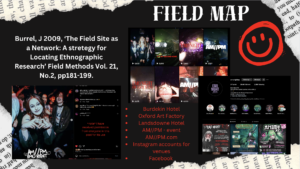In my previous post, I introduced my media niche: the intersection of alternative music culture and inclusivity within the live music scene. For this content creation project, I focused on capturing the energy and atmosphere of Emo Nights and promoting inclusivity in alternative spaces. I utilised three platforms to distribute this content: Twitter (X), Pinterest, and Instagram. Each platform allowed me to engage with different aspects of my niche, from intellectual discourse to visual aesthetics and social dynamics. You can read more about my niche exploration here.
My autoethnographic approach led me to a critical revelation during content creation: the inaccessibility of live music venues for disabled individuals. This epiphany shaped the direction of my content. On Twitter, I threaded my reflections on how the physical layout of venues-like lack of accessible bathrooms or blocked elevators-creates barriers for disabled attendees. Thus, my ethnographic study will be transformed into a critical accessibility examination. The thread included firsthand accounts of a subject’s experiences at venues like Burdekin, highlighting the disparity between inclusivity rhetoric and reality. On Pinterest, I crafted a mood board showcasing goth and emo aesthetics, from alternative fashion to subcultural symbols. Instagram Reels focused on candid clips from Emo Nights, where I reflected on the visible and invisible barriers disabled attendees face. I juxtaposed the alternative and free spirit environmental aspects with shots of inaccessible venue features, such as narrow staircases and cramped spaces.
The critical challenge was striking a balance between amplifying the voices of disabled people while also staying true to my perspective. I overcame this by prioritising collaboration and engaging with disabled friends and scholars, ensuring their experiences were represented authentically.
For Twitter, I used a thread to share detailed observations and reflections about the physical barriers in venues like Burdekin. I drew on Autoethnography: An Overview’s (Ellis et al. 2011) research, highlighting that social media can be a powerful tool for disseminating research findings and fostering community engagement. Twitter was ideal for expressing my epiphany about accessibility, using a threaded narrative to share my research and reflections. By tagging disability advocates and using hashtags like #DisabilityInclusions and #Accessible Venues, I engaged a community eager to discuss these issues.
On Pinterest, I faced the challenge of curating a mood board that blended subculture visuals with accessibility symbols in a way that still resonated with alternative music fans. Although challenging, this choice was inspired by the need to visualise the intersection between these themes. According to Mertens (2010), integrating visual elements in research dissemination can enhance understanding and accessibility, especially when addressing complex issues like accessibility and inclusion. Finding that visual balance was key to ensuring the board was aesthetically pleasing and meaningful.
Instagram Reels showcased real-time interactions and challenges within the Emo Nights scene. This platform allowed me to capture and present inaccessibility’s emotional and physical impact, aligning with Mertens’ (2010) emphasis on multimedia approaches to convey nuanced research findings effectively. The challenge was ensuring that the content was engaging and respectful, which required careful editing and a focus on genuine representation.
Through this process, I developed skills in accessibility advocacy, cross-platform content adaption, and sensitive visual storytelling while remaining focused on the themes of my media niche.
Creating and sharing content about accessibility in alternative music spaces was a transformative experience. It highlighted how media can advocate for change and raise awareness about overlooked issues. Moving from an audience member to a content creator deepened my understanding of communicating complex issues and engaging with different platforms effectively. This process demonstrated the power of integrating personal experiences with research to foster meaningful dialogue and drive advocacy within my media niche.
Ellis, C., Adams, T., & Bochner, A 2011, ‘Autoethnography: An Overview’, Forum Qualitative Sozialforschug/ Forum: Qualitative Social Research, Vol 12, No.1
Mertens, D 2010, Research and Evaluation in Education and Psychology: Integrating Diversity with Quantitative, Qualitative, and Mixed Methods. Thousand Oaks, CA: Sage Publications.
